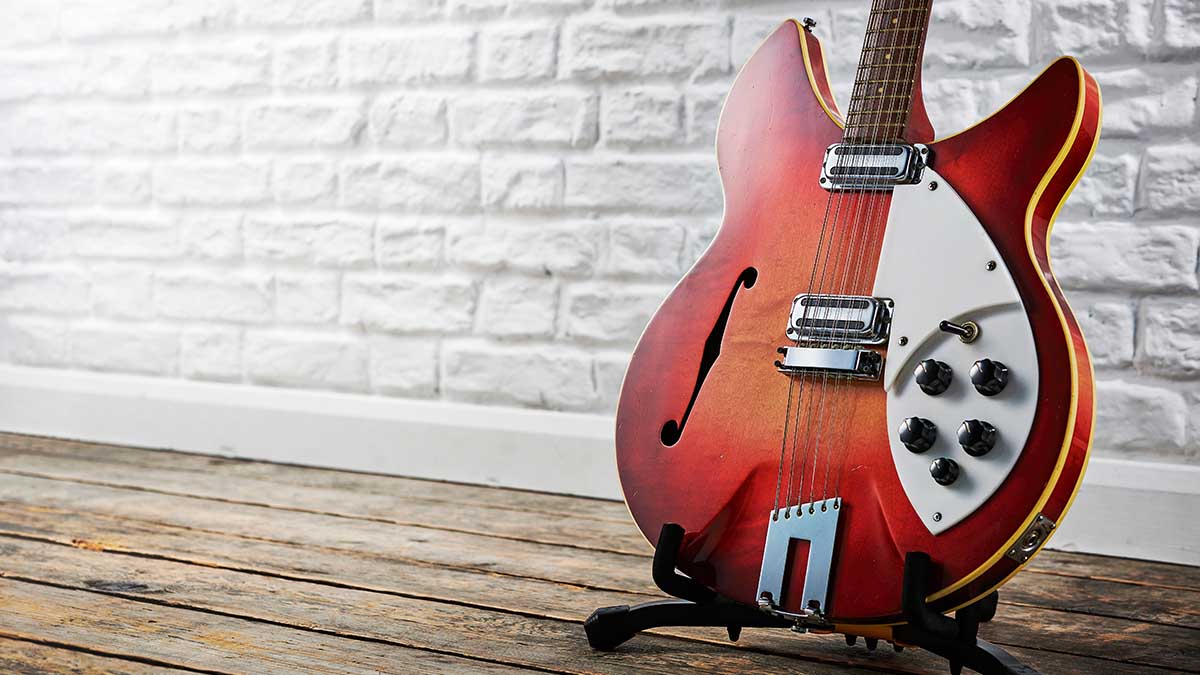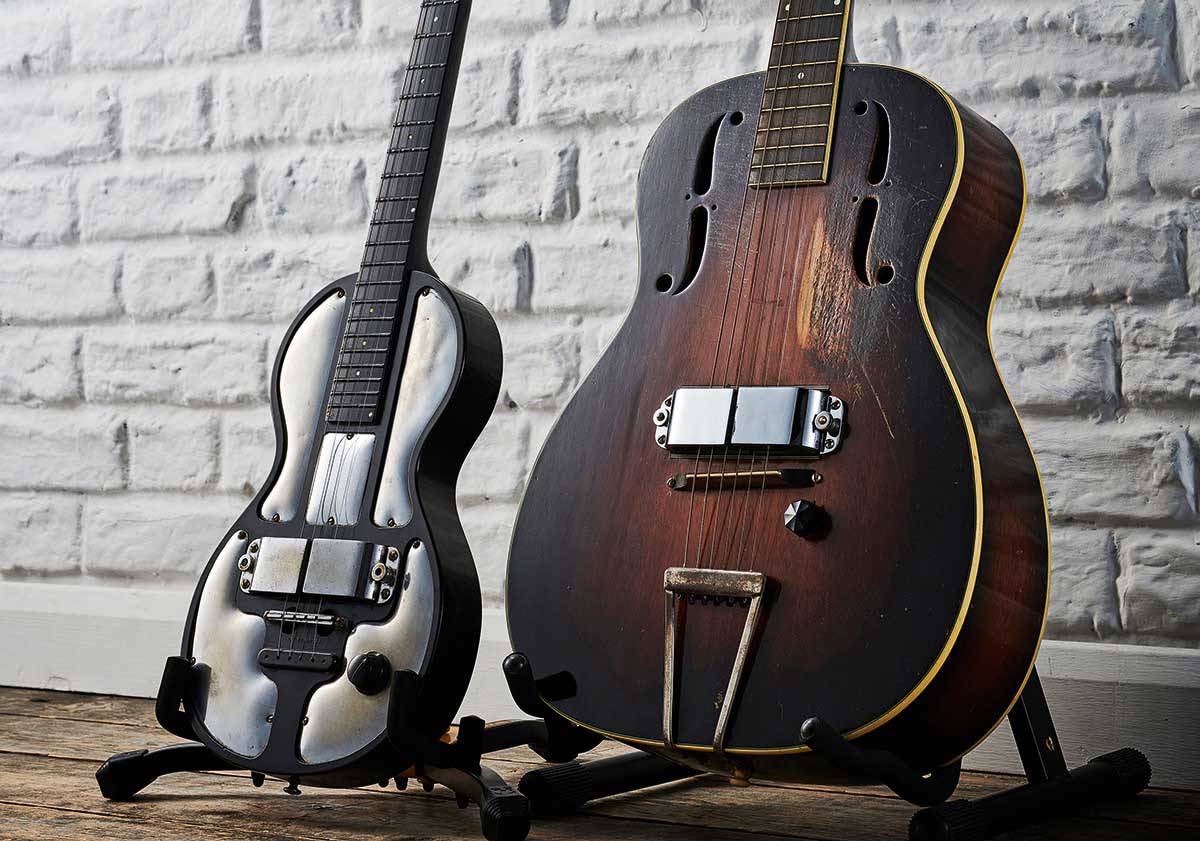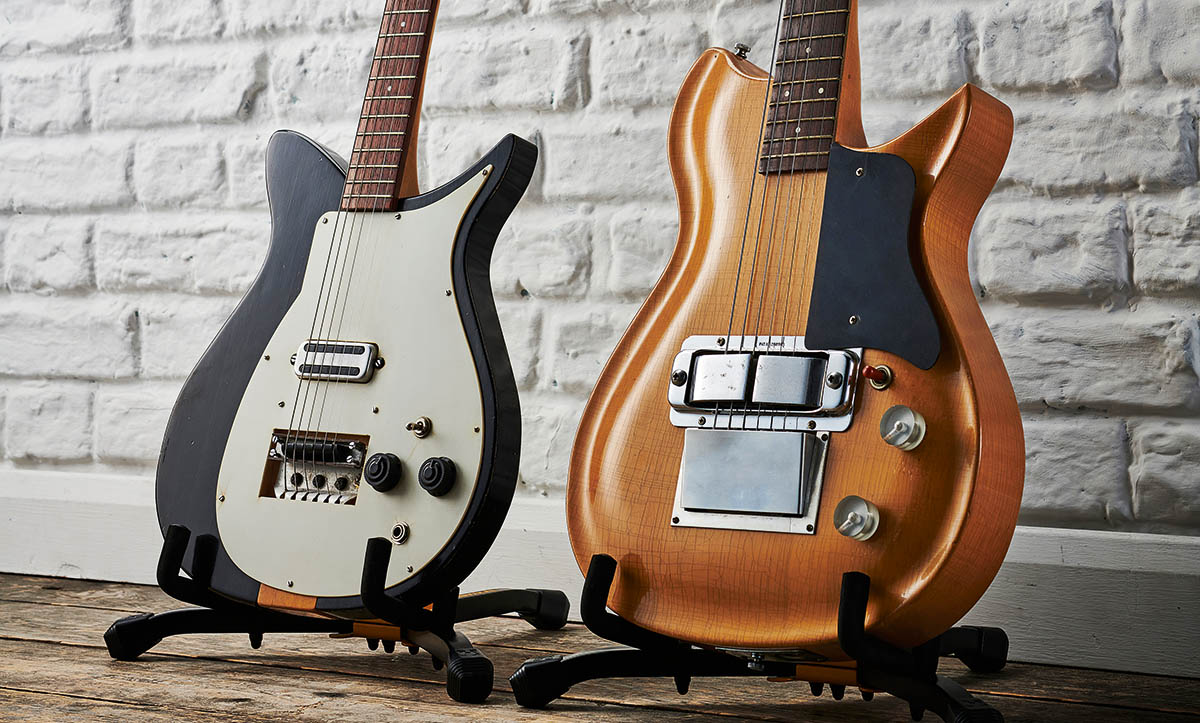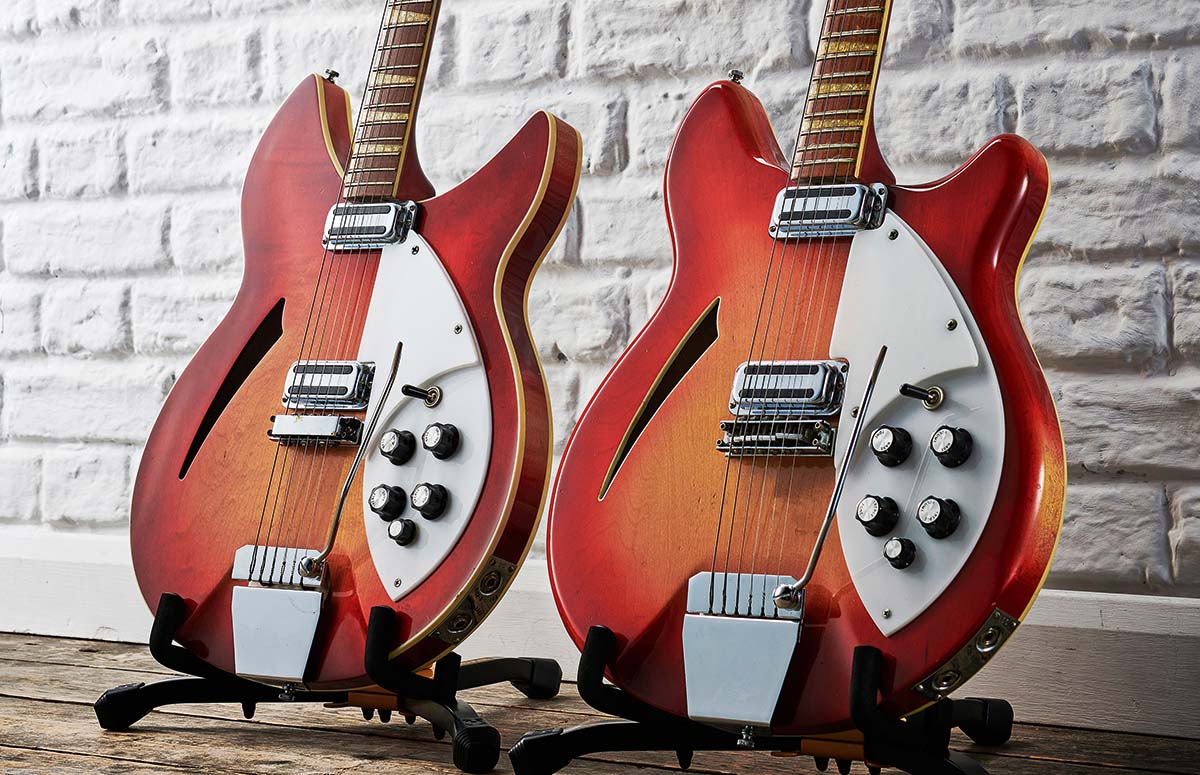How Rickenbacker evolved into one of the most iconic guitar brands in music history
Martin Kelly, co-author of Fender: The Golden Age 1946-1970, retraces the history of Rickenbacker guitars

Some 90 years ago, guitarist George Beauchamp (pronounced ‘BEE-chum’) invented the world’s first commercially viable electric guitar, which – along with its ‘horseshoe’ pickup – sparked a revolution in guitar design and sounds.
With his fellow National String Instrument Corporation associates Paul Barth and Adolph Rickenbacher, George promptly formed the Ro-Pat-In company in order to take his new invention to market with a focus on electric Spanish guitars and lap steels. It was soon to become known as the Electro String Instrument Corporation, and the firm eventually settled on the more familiar Rickenbacker name (an anglicised version of Adolph Rickenbacher’s Swiss surname).
Since then, Rickenbacker has remained one of the most important brands in pop culture and, to this day, continues to build some of the world’s finest electric guitars at its California base.
“A lot of people think Rickenbacker started out with lap steels only, but they actually brought both electric Spanish and lap steels out at the same time,” begins Martin Kelly. “I think there’s a bit of a misunderstanding that the lap steel was where they began. In truth, they knew that the application for electric Spanish guitars was there from the outset.”

With his definitive new book chronicling Rickenbacker’s 90 years of innovation set for release later this year, Martin’s painstaking research has taken him across the globe in search of answers. Today, however, we are the ones in need of answers as we stand agog at the incredible collection of vintage Rickys that Martin and his brother, photographer and filmmaker Paul Kelly, have kindly brought along to the Guitarist studios to share with us all.
So, how did the idea for the horseshoe pickup originally come about?
“To cut a long story short, George was desperate to make guitars louder,” Martin tells us. “In the 1920s, him and John Dopyera came up with the resonator guitar. You know how really old record players use a needle, a diaphragm and a horn? Well, George thought about putting a diaphragm under the bridge and that’s how him and John Dopyera came up with the [National] resonator design.
Get The Pick Newsletter
All the latest guitar news, interviews, lessons, reviews, deals and more, direct to your inbox!
He realised that electric record players had two pickup coils either side of the needle and used this principle, replacing the needle with a guitar string. That was the basis for the first electric guitar pickup
“Later, he turned to the record player principle again, but this time it was electric. He realised that electric record players had two pickup coils either side of the needle and used this principle, replacing the needle with a guitar string. That was the basis for the first electric guitar pickup, and he used horseshoe-shaped magnets to strengthen the signal.
“The pickup on this [1933 Electro Spanish, right] has six flush polepieces, but they aren’t magnetised; they’re just ferrous metal slugs. A couple of years later, George magnetised the polepieces, which increased the power of the pickup. Bodies and necks were outsourced. This Electro Spanish has a Harmony body onto which they simply mounted the pickup enabling the guitarist to be heard. George did some other pickup designs, including one where the magnets face in a different direction. He genuinely is the father of the electric guitar!”

While George Beauchamp was trying to get a patent issued for the pickup, its radical design was being ruthlessly copied by several other manufacturers.
“Rival makers quickly adopted George’s design with pickups that were more or less exact copies.” says Martin. “For a while, people must have presumed Rickenbacker were supplying Vega and other brands with pickups, but they weren’t. Competitors simply thought, ‘That’s a good idea – we should make these, too.’ And because the patent hadn’t cleared, no-one could stop them. This went on for years, and there were two main reasons why the patent application wouldn’t clear. Firstly, the patent office couldn’t decide if it was a musical instrument or an electrical appliance.
At the time, it was so radical there was no precedent set that these two things could actually be one and the same. It was a case of: is it an electrical appliance or a musical instrument? So it was going back and forth between departments and, in the meantime, everyone was copying the idea. The other reason was that they just didn’t believe it could work. In the end, Adolph Rickenbacher sent [Hawaiian musician] Sol Ho‘opi‘i to the patent office to perform in person. That was enough to finally swing it.”
Rickenbacker promised customers if the frets wore out, you could send in the old neck and get a replacement. I don’t think there’s any question Leo Fender would have taken that onboard
Beauchamp’s patent eventually cleared in 1937. By that stage, however, electric Spanish guitars had become widespread with major manufacturers such as Gibson getting in on the action, notably with its landmark ES-150 design.
“The Gibson ES-150 came along in 1936 and was mass produced. The first Rickenbackers came earlier and were also mass-produced, albeit on a much smaller scale,” points out Martin. “But as Adolph [Rickenbacher] later stated, ‘Once everyone else started making electric guitars, everyone started buying them.’ So it was good – everybody was making them, and they were becoming more popular. The very first [electric Spanish] guitar Rickenbacker made had a 17-fret neck join, which was very unusual at the time. It was made in 1932 for a guy called Gage Brewer.
“At the same time, tenor guitars were being pushed in an effort to convert banjo players to the guitar. The banjo was so popular back then that the tenor was seen as a stepping stone towards the guitar. That’s why the tenor became a thing for a while, but it was more of a fad, really. This 1935 Bakelite Electro Tenor Guitar [see previous page] has chromed steel covers over the hollowed chambers made to alleviate the weight, and the neck is bolt-on.
“Rickenbacker promised customers if the frets wore out, you could send in the old neck and get a replacement. I don’t think there’s any question Leo Fender would have taken that onboard as his electric Spanish guitars evolved from the lap steels he was building. It’s all part of the history as these designs continue to converge.”

Lap steels played a significant part in the development of the electric guitar early on and remained popular well into the 1950s.
“Lap steels were a big part of Rickenbacker’s bread and butter, even when FC Hall bought the business in December 1953,” explains Martin. “The [modern] Rickenbacker logo came in as soon as FC bought the company, and I think it may have been a Bob Perine design. He certainly did a series of ads for Rickenbacker during the mid-50s prior to being poached by Fender. After his important association with Fender, FC definitely wanted his own stake in the growing electric guitar market.
The original drawings had different headstock shapes, and Roger came up with this sweeping design. It’s the same kind of thing you see on his earlier guitars
“The first modern Rickenbacker electric guitars – the Combo 600 and Combo 800 – were introduced by FC Hall in 1954. He went to an industrial designer to come up with the shape and design, and [guitar designer/builder] Roger Rossmeisl refined it. The very first drawings – which I found in the company archive – were by someone else, but Roger definitely adapted and changed the design.
“Several of his traits are clearly evident in the early Combos. The original drawings had different headstock shapes, and Roger came up with this sweeping design. It’s the same kind of thing you see on his earlier guitars – these fluid lines.
“FC inherited a ton of the old pickups from Adolph and I’m sure he thought, ‘That’s great – I’ve got loads of pickups, so I don’t have to make any.’ So, for years, the guitars had this inherent flaw where you couldn’t palm-mute the strings as the magnets sit right in the way. But the guitar does sound good! It’s bright and it has that inherent Rickenbacker chime to it already.”

Emigrating from Germany to work for Gibson in the early 50s, Roger Rossmeisl spent a short time at the Kalamazoo factory in Michigan before departing for the sunnier climes of California and a job with FC Hall. He was also famed for his later Fender designs – notably the Telecaster Thinline, Coronado, and LTD models – but his influence at Rickenbacker cannot be overstated.
“You can see the first Combos have got a bit of Gibson in them with that top, but it’s actually a German carve, which is Roger Rossmeisl’s handiwork,” says Martin. “The Combo 600 and Combo 800 look similar, but the 800 has two toggle switches that operate two pickups, which sit side by side under the horseshoe magnets. The 600 has one pickup and one toggle switch.”
The real breakthrough with the tulip guitars was the neck-through-body design; it had never been done before
The next major phase in Ricky evolution began in ’56 with the introduction of the Combo 400 and the ‘tulip’ body shape (named in reference to the guitar’s petal-like outward-curving cutaways). By ’58, this design had morphed into the sharper inward-curving dual-cutaway style of the Capri range, while Rossmeisl’s hooked bass horn ‘cresting wave’ body shape debuted the same year with the 425 and 450 models.
“The real breakthrough with the tulip guitars was the neck-through-body design; it had never been done before,” says Martin. “That was a completely original concept that offered improved sustain when it appeared in ’56. The ‘toaster’ pickup came in during ’57 and ushered in that defining Rickenbacker chime. It looks like a humbucker, but it’s actually a single coil. I think the parallel lines are just there to make it look posh. But that’s what gives it its ’toaster’ nickname.
“So the tulip shape slowly evolved into the Capri – a new range introduced during ’58. Roger Rossmeisl made a prototype with a carved top. FC loved the design and loaned it to an LA group, which led to it being named the Polynesian. Though FC was decidedly pleased with the design, he wanted a guitar that was simpler to build without a carved top. So the next Capri Roger built had a completely flat top and that guitar – the very one – ended up becoming John Lennon’s.
“By complete fluke, the first 325 Capri ever made ended up being shipped to Germany where a young John Lennon picked it up in 1960. Which is amazing when you think about it because it’s probably a major factor as to why Rickenbacker remains so popular to this day. The serial number of Lennon’s first 325 is V81. ‘V’ is because it had a vibrato, and it’s believed the carved top one was V80.”
With The Fabs endorsing its guitars, the firm’s fortunes were set to change forever.
“The Beatles were the spark,” confirms Martin. “Suddenly, you’ve got all these British bands in the US like The Hollies, Herman’s Hermits, The Zombies and The Animals turning up on American TV shows playing Rickenbackers, and all these kids are going, ‘That’s a cool guitar!’ So many people I’ve interviewed told me, ‘I didn’t know it was an American guitar.’ The British Invasion introduced this American brand to America, a bit like how The Stones did with the blues. Like it had to go to Britain to be made popular.
“Pete Townshend took it somewhere else. He really played the hell out of his Rose Morris six- and 12-string models. If you get a 12-string, you can play pick-y stuff like [Roger] McGuinn, but if you hit it hard, you can really get the sound of those early Who records. Pete often played a 1993 with flat-wounds, and he hammered the fuck out of it.
Rickenbackers are beautifully made. I think they’ve got a great aesthetic, which really sets them apart. They’ve got an iconic look and there aren’t many brands who can boast that
“It’s such a great sound and similar to how [Paul] Weller played Rickenbackers. Guy Picciotto from Fugazi is the same – he’s very heavy-handed with it. If you think of those three guitarists – Townshend, Weller and Picciotto – they all play in a harder style. Rickenbackers have a delicate feel to them, but they’re pretty tough. Especially the way they’re built now.
“Rickenbackers are beautifully made. I think they’ve got a great aesthetic, which really sets them apart. They’ve got an iconic look and there aren’t many brands who can boast that. Fender, Gibson, Gretsch and Rickenbacker really are the top four. In terms of what was designed in the first 20 years of the electric guitar, Rickenbacker are squarely in the pantheon. That’s why Roger Rossmeisl is so important. To date, he’s gone relatively unrecognised, although it seems more people have become aware of him within the last few years. In many ways, he was Rickenbacker.”
- Martin & Paul Kelly’s new book, Rickenbacker Guitars 1931-1999: Out Of The Frying Pan Into The Fireglo, is due for release in October via Phantom Books.
Rod Brakes is a music journalist with an expertise in guitars. Having spent many years at the coalface as a guitar dealer and tech, Rod's more recent work as a writer covering artists, industry pros and gear includes contributions for leading publications and websites such as Guitarist, Total Guitar, Guitar World, Guitar Player and MusicRadar in addition to specialist music books, blogs and social media. He is also a lifelong musician.
“The nuisance is exacerbated by the repetition and poor quality of some of the performances”: Buskers banned from London’s Leicester Square as performances likened to “psychological torture”
“It went wrong since Corona”: Bax Music, one of Europe’s largest musical instrument retailers, files for bankruptcy and ceases operations


![A black-and-white action shot of Sergeant Thunderhoof perform live: [from left] Mark Sayer, Dan Flitcroft, Jim Camp and Josh Gallop](https://cdn.mos.cms.futurecdn.net/am3UhJbsxAE239XRRZ8zC8.jpg)








